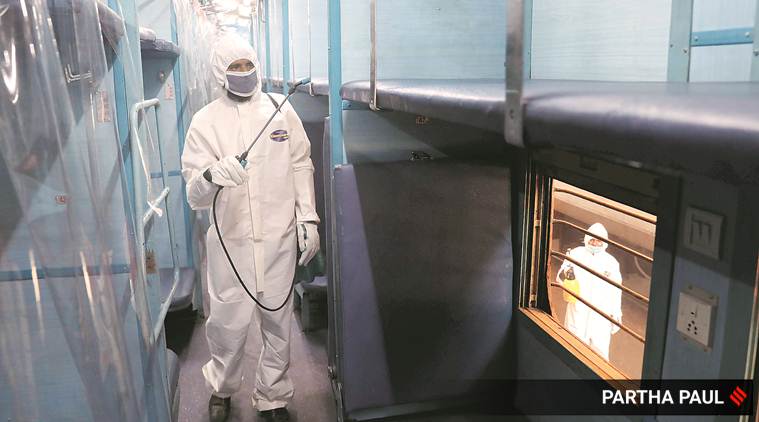 A train coach converted into a coronavirus isolation ward being disinfected at Tikiapara railway car shed, Howrah. (Express photo by Partha Paul)
A train coach converted into a coronavirus isolation ward being disinfected at Tikiapara railway car shed, Howrah. (Express photo by Partha Paul)
Around 27 per cent of the 215 railway stations selected for the deployment of the “isolation coaches” are in districts that are designated green zones, where there have been no new or confirmed cases of COVID-19 in the past 28 days.
Even though the number of cases has touched 52,952 and the government projects that the spike will continue, around 59 stations earmarked for deployment of the train coaches fall in the green zones in states like Assam, Andhra Pradesh, Tripura Odisha, Uttarakhand and others, giving a peek into the Centre’s strategy in the face of a surge in cases in the coming weeks.
Around 32 per cent of the stations are spread across red zones, which are severe hotspots and have a high growth-rate of new cases. The rest are in orange zones.
Officials said the strategy of identifying so many stations, which are not hotspots or are more or less free from new cases, has been guided by the availability of the infrastructure to host the coaches — the station should have a charging point for the electricals, and it should have the facility of supplying water to the train.
Another factor that has gone into preparing the list is the availability of a COVID hospital nearby to service these trains. Each train is supposed to have 10 isolation coaches.
Of the 8,000-odd railway stations in India, thousands have watering and charging facilities. These 215 have been chosen as per a plan, a key official linked to the government’s outbreak containment strategies told The Indian Express.
“The colour code of a district is revised periodically. We have chosen these stations as strategic points so that either patients can be brought here or these coaches can be sent to an area that requires this facility. The states will decide when to deploy them in coordination with Railways,” he said.
According to an analysis by The Indian Express, at least 69 stations are in districts which are hotspots in red zones with heavy patient load. Uttar Pradesh has 10 such districts, Maharashtra has 11, West Bengal and Rajasthan have 7 each—the top four. Other districts making the list are in Andhra Pradesh, Delhi with three districts, Gujarat, Telangana, Bihar and others. At least 79 stations are in orange zones in these states.
The NITI Aayog estimates that the number of cases could touch 65,000 as early as May 15 and 2.74 crore on August 15. So far 20 per cent of India’s almost 53,000 cases have needed hospitalisation. There are 5,250 isolation coaches prepared at a cost of around Rs 100 crore from the government’s COVID fund.
In inter-ministerial consultations, Railways have stressed that since these are mobile units, they can travel to any part of the country when needed, but they need to have a “base” of sorts where a COVID hospital can service it, in case the patients develop severe symptoms. Another idea that has been discussed is, like France’s TGV, these coaches are used to transport patients from one place where there are inadequate healthcare facilities to a hospital which can admit them.
“The use of these coaches, as envisaged by the government, is that in case the patient load in any area is too much for hospitals and quarantine centres to accommodate, a suspected case from nearby areas can be brought to these coaches stationed somewhere and observed in isolation,” said Arun Arora, Principal Chief Mechanical engineer of Northern Railway. “The idea is to isolate a person, who may be living in a small house with several family members, either in a village or a congested urban hotspot, and bring him to these coaches or take the coaches to the nearest railway station.”